Five images that explain why the LA fires spread so fast
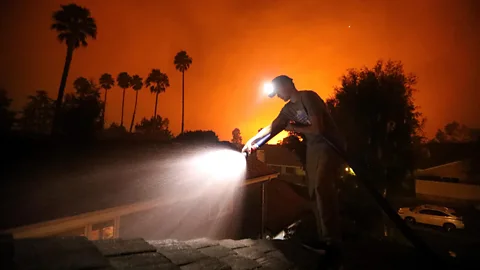 Getty Images
Getty ImagesFrom more vegetation to flying embers, the BBC Earth team look at why the fires in LA have been so intense and why they've grown so rapidly.
The flames spread with terrifying speed. As residents of the Pacific Palisades neighbourhood to the west of Los Angeles started to see smoke rising from the hills opposite their homes on the morning of 7 January, the fire was already around 10 acres in size. Within 25 minutes it had grown to cover an area of more than 200 acres.
Over the hours that followed the blaze would spread, engulfing homes, theatres, restaurants, shops, schools – entire communities. By the early morning of 9 January, the Palisades fire covered an area of 17,234 acres and other blazes had broken out across the LA area, becoming one of the worst fires in LA's history, according to AccuWeather's chief meteorologist Jonathan Porter. An early estimate of damage has put the cost of the fire between $52-57bn (£42-46bn).
Why have the fires been so intense and why have they grown so rapidly? Here are five reasons.
Rapid fuel growth
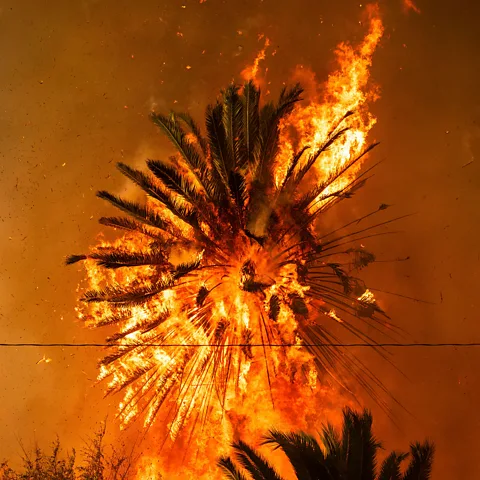 Getty Images
Getty ImagesA period of heavy rainfall in 2024 linked to El Niño is thought to have led to conditions with a high risk of fire this winter.
Watch live
Follow BBC News' coverage of the LA fires on our live page.
"Rain is often thought of as generally a bad thing for fires, and if the rain is happening during the fire, then that is a bad thing for the fire," says Rory Hadden, fire science researcher at the University of Edinburgh. But rainfall prior to a fire can mean lots of vegetation growth, which then becomes potential fuel. "And then you enter a period of drier weather, and then that vegetation dries out very, very quickly, and there's more of it. So, you can build up more fuel."
The period of wet weather in 2024 followed by a drier period produced the "perfect conditions for wildfires to spread", wildfire scientist Maria Lucia Ferreira Barbosa of the UK Centre for Ecology & Hydrology said in a statement.
This switch from very wet to very dry weather is known as "hydroclimate whiplash". One recent paper found that risk of hydroclimate whiplash has increased by between 31 and 66% globally since the middle of the 20th Century.
Santa Ana 'hairdryer' winds
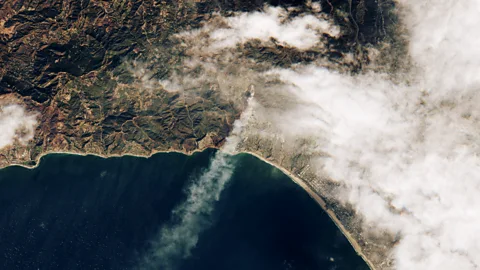 Nasa Earth Observatory
Nasa Earth ObservatoryThe fires have also been fanned by a powerful windstorm. The strong winds drove flames that started in the mountainsides to the west of Los Angeles into a fast-moving wildfire, which spread through already dry vegetation to engulf the Pacific Palisades neighbourhood near Santa Monica. The winds themselves are often hot and dry so can whip further moisture out of the vegetation.
"[With] all wildfires you need three things. You need some kind of ignition, you need something to burn, and you need some oxygen from the air," says Hadden. "But the thing that's made these fires so incredible is the speed of the winds that are coming in from the centre of the California Desert."
These are known as Santa Ana or Föhn winds and they can cause wildfires to behave erratically. "Those winds are very, very dry. They're moving very, very fast, so as soon as a fire starts it's very easy for it to get hold and then to grow and to spread really, really rapidly," says Hadden. "We've seen winds reported at more than 100mph [160 km/h]. So, of course, that just really fans the flames and pushes those fires from wherever it is that they have started very rapidly through the landscape."
In some cases these windstorms can even be the cause of fires themselves, bringing down power cables that then ignite nearby vegetation.
Firebrands
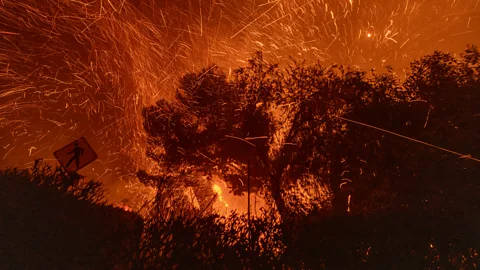 Getty Images
Getty ImagesThese winds don't just fan the flames and push the fires through the natural world. They also carry embers. These embers, or firebrands, are the leading cause of structure loss in wildfires, says Hadden.
"Things get in the way of the flames [such as roads or buildings]," says Hadden. "But nothing stops these firebrands and they travel."
The winds can whip up embers from burning vegetation and carry them forward. They can spill just a few metres in front of a blaze, igniting new material, or leapfrog several miles at a time, causing new fires to ignite some distance away. "There's reports of tens of kilometres that these things have travelled, and they will land in crevices around a house, maybe some ornamental vegetation, and they will start burning the houses," says Hadden.
If an ember ignites a single house, it can be possible for fire services to put it out. "But the problem is, it's tens of houses [that] often get ignited simultaneously with these firebrands, and then each house generates loads more firebrands," says Hadden. "So you have this kind of domino effect of these firebrands that are being carried by the wind."
As well as causing damage to property, the firebrands are extremely dangerous to people in their path too.
"It was like a vortex of embers, there was no oxygen," Alec Gellis told CBS News, the BBC's US partner, whose girlfriend's house was set alight by the fires. "I barely even made it to my car."
Hills and canyons
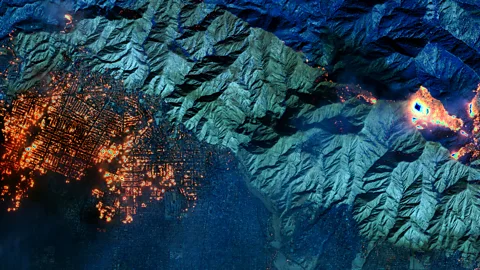 Getty Images/ Maxar
Getty Images/ MaxarThe area's hilly landscape also raises the risk posed by wildfire.
"Fires will spread extremely rapidly uphill," says Hadden. "Geographical features like canyons, ravines – these sorts of things can create very extreme fire behaviours that are challenging – impossible, maybe – for anyone to really fight as a fire."
This topography not only raised the risk of the spread of the fires, but also makes evacuation more difficult. In the Palisades area, the narrow hillside roads pose an additional challenge for people attempting to leave. Read more about why LA was so hard to flee when the fires broke out.
Climate change
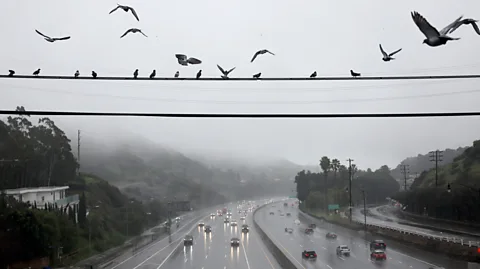 Getty Images
Getty ImagesThough it is too early to establish whether or how much climate change contributed to these fires, climate change has been linked to worsening wildfires globally. The number of days where the weather leads to a high risk of fire is increasing, and climate change is making these conditions more severe, Matt McGrath reports for BBC News.
The risk isn't as simple as the world getting hotter, says Hadden. It's also about the range of extremes that we are seeing.
"It's the hotter weather, but it's also coupled with the more extreme wind conditions, more extreme rain events that allows vegetation to grow. So, we are navigating this huge change in not just hotter, drier, but also wetter and windier [weather], and everything else that comes together from the climate point of view. That's what is going to define the risk going forward."
--
For essential climate news and hopeful developments to your inbox, sign up to the Future Earth newsletter, while The Essential List delivers a handpicked selection of features and insights twice a week.
